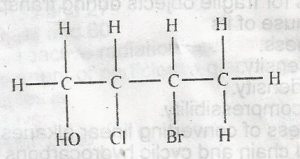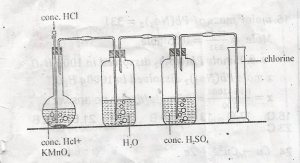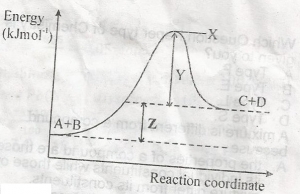Year :
2014
Title :
Chemistry
Exam :
JAMB Exam
Paper 1 | Objectives
41 - 45 of 45 Questions
| # | Question | Ans |
|---|---|---|
| 41. |
The process of converting linear alkanes to branched chain and cyclic hydrocarbons by heating in the presence of a catalyst to improve the quality of petrol is referred to as A. refining B. cracking C. reforming D. blending |
C |
| 42. |
The petroleum fraction that is used in heating furnaces in industries is A. diesel oil B. gasoline C. kerosene D. lubricating oil |
A |
| 43. |
 The IUPAC nomenclature of the compound above is A. 2-bromo-3-chlorobutanol B. 3-bromo-2-chlorobutanol C. 3-chloro-2-bromobutanol D. 2-chloro-3-bromobutanol |
B |
| 44. |
 In the diagram, the function of the concentrated H2SO4 is to A. purify the gas B. dry the gas C. liquefty the gas D. remove odour |
B |
| 45. |
 Z in diagram above represents A. heat of reaction B. activation energy C. free energy D. entropy of reaction |
A |
| 41. |
The process of converting linear alkanes to branched chain and cyclic hydrocarbons by heating in the presence of a catalyst to improve the quality of petrol is referred to as A. refining B. cracking C. reforming D. blending |
C |
| 42. |
The petroleum fraction that is used in heating furnaces in industries is A. diesel oil B. gasoline C. kerosene D. lubricating oil |
A |
| 43. |
 The IUPAC nomenclature of the compound above is A. 2-bromo-3-chlorobutanol B. 3-bromo-2-chlorobutanol C. 3-chloro-2-bromobutanol D. 2-chloro-3-bromobutanol |
B |
| 44. |
 In the diagram, the function of the concentrated H2SO4 is to A. purify the gas B. dry the gas C. liquefty the gas D. remove odour |
B |
| 45. |
 Z in diagram above represents A. heat of reaction B. activation energy C. free energy D. entropy of reaction |
A |